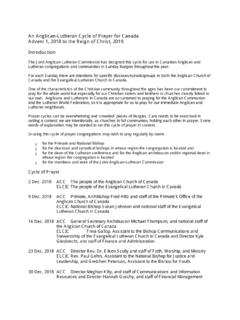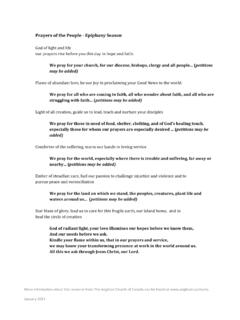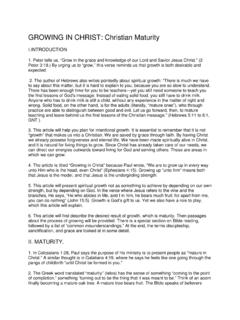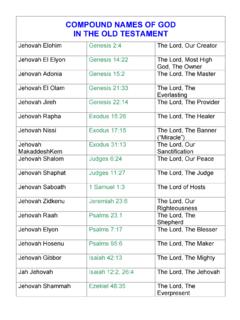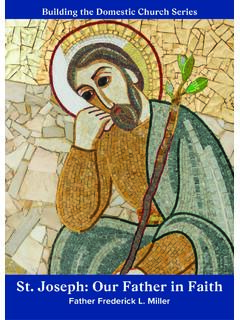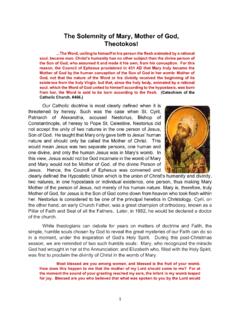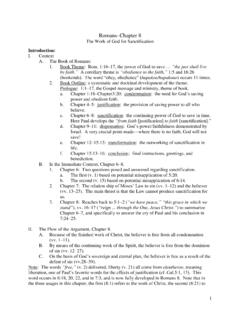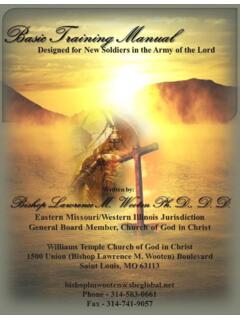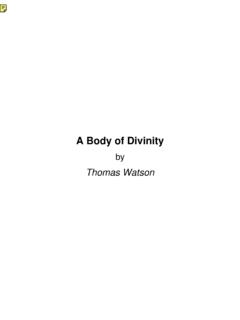Transcription of ALTERNATIVE COLLECTS FOR YEARS A, B & C OF THE …
1 ALTERNATIVE COLLECTS FOR YEARS A, B & C OF THE REVISED COMMON LECTIONARY AND SEASONAL PRAYERS OVER THE GIFTS AND AFTER COMMUNION Prepared by the Liturgy Task Force, Faith, Worship, and Ministry Committee Of the General Synod of the Anglican Church of Canada INTRODUCTION The Task In 1983 the Doctrine and Worship Committee presented the General Synod with a draft Book of ALTERNATIVE Services which required further editing and revision. General Synod au-thorized the Doctrine and Worship Committee to complete its work and to permit the Na-tional Executive Council to publish the work upon its completion.
2 When The Book of ALTERNATIVE Services was published in 1985, it followed the pattern of The Book of Common Prayer (TEC 1979) by providing one collect for each occasion in the lectionary. In addition to the collect, The Book of ALTERNATIVE Services included a prayer over the gifts and a prayer after communion. It became quickly apparent that having only one collect was unsatisfactory. If, as the in-troduction to the Holy Eucharist in The Book of ALTERNATIVE Services states, the collect of the day provides the transition to the readings for the day (p.)
3 174), then what is the community to make of a collect that has no connection at all to what is to be read? For this reason, General Synod 2010 authorized Faith, Worship and Ministry to establish a Task Force, one of whose tasks was the preparation of a three-year cycle of COLLECTS that provide a genuine transition to the readings for the day. The Lectionary The General Synod of 1998 authorized replacing the Common Lectionary (1983) with the Revised Common Lectionary (1992) with some revisions to accommodate the liturgical rites of The Book of ALTERNATIVE Services.
4 The General Synod also stipulated that the semi-contin-uous readings from the Hebrew Scriptures would be used on the Sundays following Trinity ra-ther than the ALTERNATIVE complementary readings. With the adoption of the Revised Common Lectionary the observance of the Second Sunday in Lent as a precursor of the Transfiguration was transferred to the Last Sunday after Epiphany. The Working Group followed this practice and makes no provision for the alterna-tive Transfiguration gospel reading on the Second Sunday in Lent.
5 Congregations are free to choose to use the Transfiguration gospel on the Second Sunday in Lent. If a congregation 2 chooses to do this, then they should not use the trial use COLLECTS and readings for the Last Sun-day after Epiphany. The COLLECTS The Propers Working Group has used three approaches to our work: (i) we have cre-ated COLLECTS ; (ii) we have adopted COLLECTS from other sources; and (iii) we have adapted col-lects from other sources. We have chosen language that we believe to be faithful to the Scrip-tures and food for the theological and spiritual imagination of the gathered community.
6 Some of the COLLECTS follow a structure familiar to Anglicans, while others do not. All, however, are expressions of the Christian faith rooted in the Scriptures and the ecumenical creeds. The traditional shape of a collect is (i) an opening address to God, (ii) a description of God s saving activity, (iii) a petition that this activity continue in the present and (iv) a trinitarian conclusion. In recent YEARS evocative COLLECTS have been composed that follow this pattern with the exception of a traditional conclusion.
7 Many of the COLLECTS that follow reflect this con-temporary usage. In them our faith in God who reveals the divine self in three persons is ex-pressed even if a traditional formula is not used. (See An Excursus on Concluding Doxologies at the end of this document.) With these trial use texts the worshipping communities of the Anglican Church of Can-ada will have a choice of four COLLECTS : (i) the collect from The Book of ALTERNATIVE Services, (ii) the collect from Evangelical Lutheran Worship (where permitted by the Ordinary) and (iii) two trial use COLLECTS .
8 Communities will have a similar choice regarding the prayer over the gifts and the prayer after communion: (i) the prayers from The Book of ALTERNATIVE Services and (ii) the seasonal prayers from Evangelical Lutheran Worship. These choices will permit liturgical planners to choose prayers which serve the context of their community and to explore new language for the mystery of creation, redemption and sanctification made known to us by God through Jesus Christ and in the power of the Holy Spirit.
9 The Seasonal Prayers over the Gifts and after Communion The Prayer over the Gifts focuses not only on the gifts of bread and wine, but on the whole work of the people of God (BAS 1985, 177). In a similar vein the Prayer after Commun-ion asks God to grant the effect of the eucharist to the people, so that we become in action what we have received in sacrament (BAS 1985, 181). Therefore, instead of preparing a prayer over the gifts and a prayer after communion for each occasion, we have recommended the use of the seasonal prayers from Evangelical Lutheran Worship.
10 In reference to the Prayers over the Gifts and after Communion we have chosen to use the term Ordinary Time to designate those Sundays from the Second Sunday after Epiphany to 3 the Last Sunday after Epiphany and from the Second Sunday after Pentecost to the Reign of Christ. Sources When using prayers from this resource, all prayers are to be used unaltered, unless permission is granted by the General Synod of the Anglican Church of Canada, through the Director of Faith, Worship, and Ministry All source citations must be in-cluded in any worship resources produced for congregational use.
